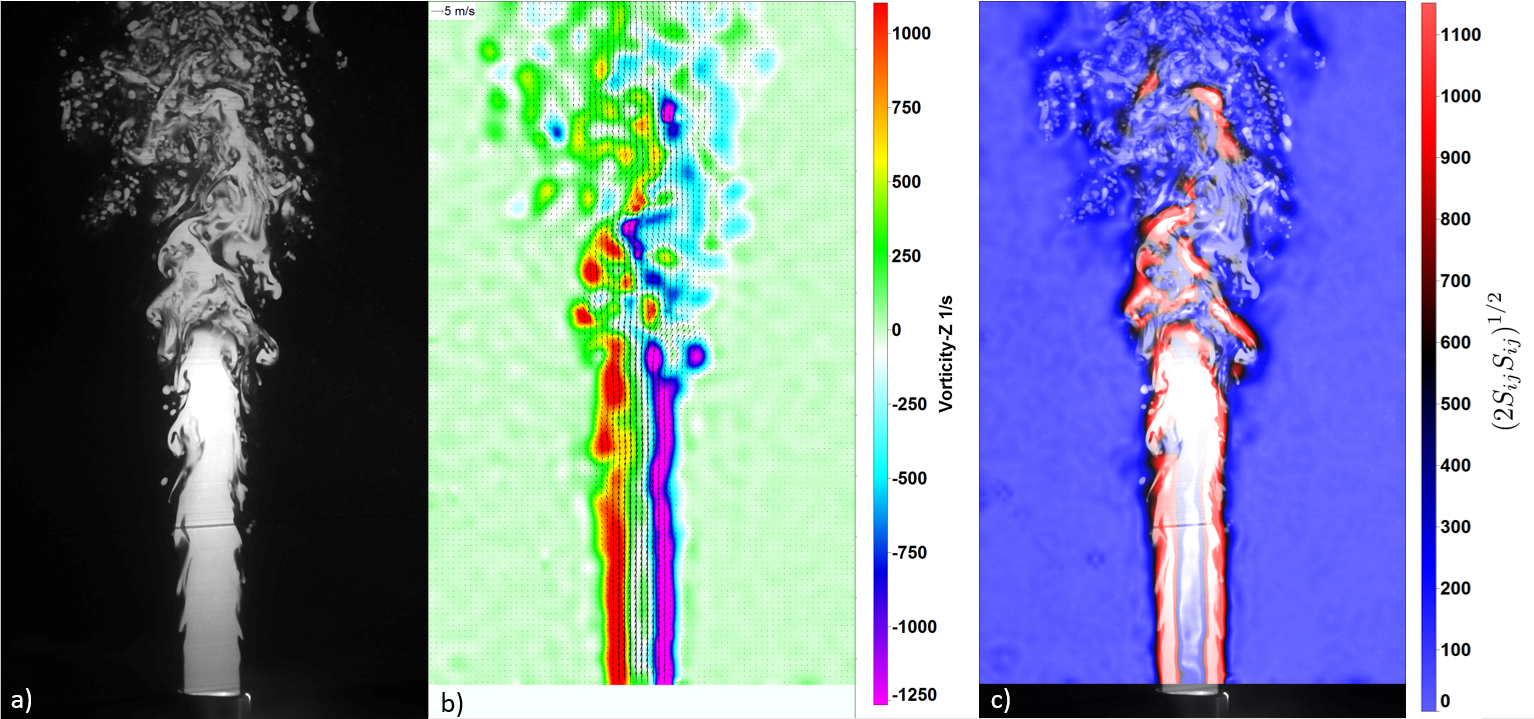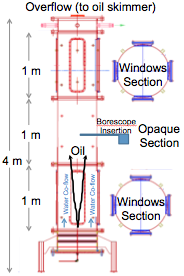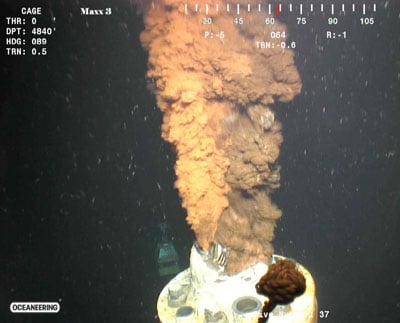People
| Postdoc | Lakshmana Chandrala, Omri Ram |
| Former Postdoc | David W. Murphy, Pranav R. Joshi |
| Graduate Student | Xinzhi Xue |
| Former Graduate Student | Kaushik Sampath, Cheng Li |
| Undergraduate Student | Anne Hosler, David Morra, Ben Chello, Yvana Ahdab, Kyle Candela |
| Project Supervisor | Prof. Joseph Katz |
| Design & Technical Support | Dr. Yury Ronzhes |
Background
Oil and methane were ejected from the Macondo well blowout and formed a rising plume.
Goals
The project aims to study the formation and breakup of an oil and gas plume in the laboratory.
The Large-Scale Plume Facility includes three interchangeable sections with different degrees of optical access, ports for borescope insertion and windows for high speed filming.
Experimental Detail
Immiscible turbulent jets/plumes, such as those developing during subsurface oil-well blowout, break up into droplet clouds shortly after injection. The instabilities and mechanisms affecting the fragmentation process have not been probed or modeled adequately owing to the limited ability to observed phenomena occurring within dense multiphase suspensions. Furthermore, understanding of subsequent mass and momentum transport phenomena requires accurate data on the droplets size distribution resulting from this fragmentation process [1]. Depending on the properties of the fluids, the size of these droplets can vary from submicron to millimeter [2]. Numerous experimental studies have investigated these processes using a variety of tools, such as shadow-graphic, ballistic, and X-ray imaging (e.g. [3, 4]). These techniques have yielded valuable data on the phase distributions, but they do not provide quantitative details on flow structure involved with the fragmentation process, and how it affects the droplet statistics.
To overcome this challenge, we use a refractive index-matched pair of immiscible fluids, silicone oil and 64% by weight sugar water, as a surrogate for crude oil and seawater, respectively. To maintain dynamic similarity the density and kinematic viscosity ratios as well as interfacial tension between these fluids are closely matched with those of crude oil and seawater. The oil is tagged with a fluorescent dye that is soluble only in the oil, and both phases are seeded with particles for PIV measurements. Careful matching of the refractive indices (1.4022) enables simultaneous measurements of the spatial distribution of the oil phase, including the droplet statistics, and the velocity field over the entire domain. Consequently, in enables direct measurements of processes occurring as the shear field fragments the jet/plume to ligaments, followed by breakup into droplets.
 Figure 1. Sample simultaneous images of: a) oil phase fluorescence, b) velocity and vorticity distributions (c) overlaid distributions of oil phase (white) and the strain rate magnitude.
Figure 1. Sample simultaneous images of: a) oil phase fluorescence, b) velocity and vorticity distributions (c) overlaid distributions of oil phase (white) and the strain rate magnitude.
In on-going measurements, the central radial-axial plane of the jet is illuminated by a laser sheer. The images are recorded by two high speed cameras (PCO.dimax), one without any filtering, where the image is overwhelmed by the oil fluorescence, and the other with a band-pass filter that transmits the laser wavelength and scattering from the particles, but filters out the fluorescence, allowing acquisition of PIV data in both phases. Results clearly show that with increasing jet Reynolds and Weber number, the oil plume breakup occurs closer to the nozzle, the spreading angle of the oil jet increases and the characteristic droplet sizes decrease. Figure 1a is a sample image of the oil phase fluorescence, Figure 1b is the corresponding vorticity and velocity distributions obtained from the PIV measurements, and Figure 1c is an overlay of oil phase distribution and the shear strain rate magnitude. The observations indicate that oil is stretched and broken to ligaments in the high strain rate regions, especially at the end of the potential core, which subsequently break up into droplets. The location of peak RMS value of shear rate 4-7 nozzle diameters away from the nozzle is consistent with the location of early plume breakup. The difference in droplet size distribution affects the droplets buoyancy and inertia, resulting in an increasing spreading rate of the plume with increasing Weber Number. As oil ligaments stretch and break into droplets, they often entrain water, resulting in secondary water droplets encapsulated within oil droplets. Multiple layering also occurs, creating a “Russian Doll” like phenomenon, as illustrated in Figure 2. Such compound droplets form in about 11% of the cases. The fraction of oil in these compound droplets affects their buoyancy, slip velocity, Stokes number, and Froude number. Hence, it should be accounted for while modeling the droplet breakup, transport and plume spreading.
Publications
Chandrala, L. D., Afshar-Mohajer, N., Nishida, K., Ronzhes, Y., Sidhaye, V. K., Koehler, K., & Katz, J. (2019). A Device for measuring the in-situ response of Human Bronchial Epithelial Cells to airborne environmental agents. Scientific reports, 9(1), 1-12.
Sampath, N. A. Mohajer, L. Chandrala, W. Heo, J. Gilbert, D. Austin, K. Koehler, and J. Katz., (2019). Aerosolization of crude oil‐dispersant slicks due to bubble bursting. Journal of Geophysical Research: Atmospheres, 124(10), 5555-5578.
Li, C., Miller, J., Wang, J., Koley, S. S., & Katz, J. (2017). Size distribution and dispersion of droplets generated by impingement of breaking waves on oil slicks. Journal of Geophysical Research: Oceans, 122(10), 7938-7957.
Murphy, D. W., Xue, X., Sampath, K., & Katz, J. (2016). Crude oil jets in crossflow: effects of dispersant concentration on plume behavior. Journal of Geophysical Research: Oceans, 121(6), 4264-4281.
Murphy, D. W., Li, C., d’Albignac, V., Morra, D., & Katz, J. (2015). Splash behaviour and oily marine aerosol production by raindrops impacting oil slicks. Journal of Fluid Mechanics, 780, 536-577.
Murphy, D., Morra, D., & Katz, J. (2013). Rain Drops and Oil Slicks: Impact of Water Droplets on a Surface Oil Layer. 66th Annual Meeting of the Division of Fluid Dynamics, Bulletin of the American Physical Society, 58.
Katz, J., Murphy, D., & Morra, D. (2013). Large Scale Behavior and Droplet Size Distributions in Crude Oil Jets and Plumes. 66th Annual Meeting of the Division of Fluid Dynamics, Bulletin of the American Physical Society, 58.
Li, C., Holser, A., & Katz, J. (2013). Breakup of an oil slick mixed with dispersants by breaking wave. 66th Annual Meeting of the Division of Fluid Dynamics, Bulletin of the American Physical Society, 58.



